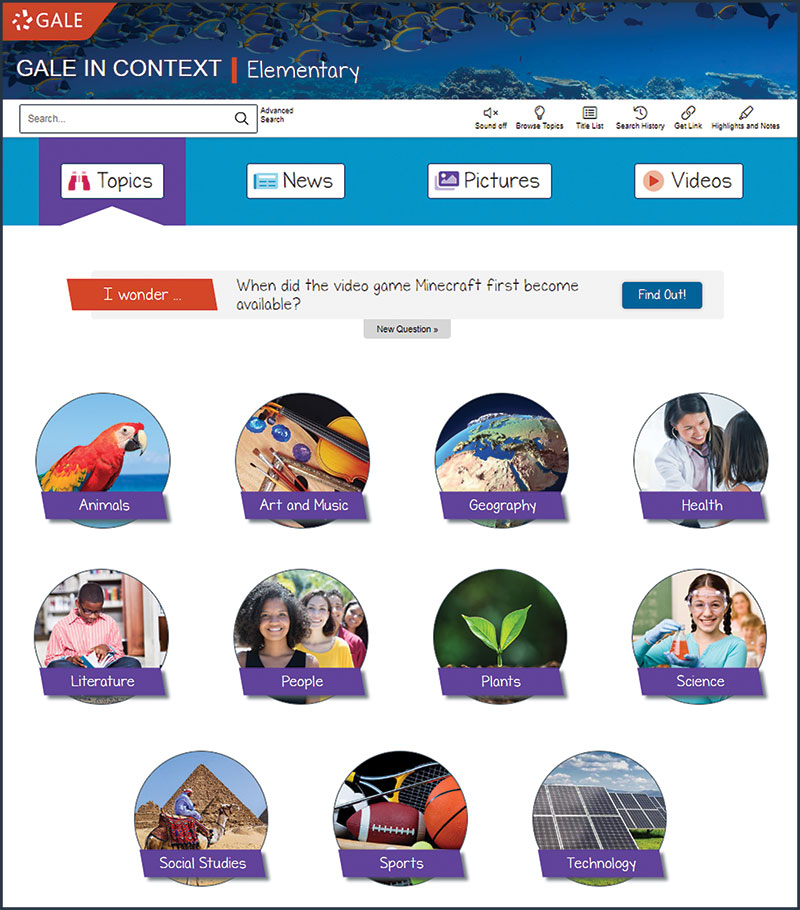Gale In Context: Elementary | Reference Database Review
Like other databases in Gale’s growing In Context suite, this one offers a simple, standardized search interface for a large set of Gale resources, including print articles from a variety of publications, as well as videos and more than 16,000 images.
Grade level Gr 1-5
Cost Pricing is subscription-based and calculated using full-time enrollment. Institutions wishing to purchase multiple In Context products with Gale In Context: Elementary will receive special pricing. A free trial for the product can be requested.
Like other databases in Gale’s growing In Context suite, this one offers a simple, standardized search interface for a large set of Gale resources, including print articles from a variety of publications, as well as videos and more than 16,000 images. An enhancement of the product formerly known as Kids InfoBits, it promises to introduce elementary students to database searching with “age-appropriate, reliable, curriculum-related content.”
Upon logging in, users encounter a top-level menu that breaks down browsable content across four tabs: topics, news, pictures, and videos.
Unlike in Gale In Context: High School version, the Elementary homepage does not feature selected searches on specific topics. Instead, as in Gale In Context: Middle School, there’s an array of photo icons representing broad topics, such as arts and music, plants, or technology. Clicking on any of those icons opens up a new page of subcategories. Under geography, for instance, users will find “maps and globes,” “lakes and rivers,” “U.S. states,” and more.
Beneath the main search box are a series of rotating questions. Clicking a “Find Out!” button leads to a relevant article that answers the query.
The “news” tab includes links to articles such as “What Will Schools Looks Like in the Fall?” from elementary-focused publications including the Washington Post’s KidsPost, Scholastic News, and YoungZine. Below that is a listing of fun facts for the month in question, such as Meteor Watch Day, along with links to relevant entries.
The “pictures” and “videos” tabs display resources that appear to be randomly laid out, but a search box at the top of the page allows students to conduct specific queries.
A standard search box runs across the top of the page.
A search for “humpback whale” yields links to six books or book excerpts, 16 news articles, 32 magazine articles, and nine images, enough to provide a range of results without overwhelming younger or less experienced users. One of the books, Humpback Whales: Singers of the Seas by Kris Hirschmann, is somewhat out of date, published in 2003, but the entry is rich, including links to external websites, a bibliography of five additional books, and a glossary, though the links are not active and users must copy and paste them into a browser.
A search for “Donald Trump” brings up at least one biographical article that has been updated to the spring of this year and includes information about the COVID-19 pandemic.
An advanced search link allows students to conduct a Boolean search, with options like keyword, publication title, and ISBN, as well as additional parameters such as document type, content level, and Lexile level.
Articles are classified by reading level, indicated in search results by a small icon with a number of dots. In some cases, users will find differently leveled versions of an article or more than one article about the same subject, separated by tabs and labeled by level, which could be useful for differentiating instruction.
Student and teacher resources Each article includes a toolbar of controls; users can opt to have the text read out loud, increase or shrink text size, translate into more than three dozen languages, and display more information about the article. Text is automatically highlighted as it is read aloud and can be downloaded as an MP3 file.
Users can also generate citations (in MLA, APA, and Chicago formats); export them to NoodleTools, EasyBib, RefWorks, Google Drive, or One Drive; send an article to Google Drive or OneDrive; or email, download, or print it.
A “browse topics” button on the main toolbar opens up a lengthy alphabetical list of subjects. A drop-down menu allows students to filter by topic.
An “educator resources” link at the bottom of the main page brings up a directory of tutorials, webinars, FAQs, a guide to reading levels, and other training materials.
Verdict The interface is clean and intuitive and the content timely. Whether as an environment for teaching younger students about database searching or providing a platform for exploring on their own, for informal browsing or for targeted searching, Gale In Context: Elementary is an excellent resource.
Bob Hassett, Luther Jackson M.S., Falls Church, VA
RELATED
The job outlook in 2030: Librarians will be in demand
The job outlook in 2030: Librarians will be in demand
ALREADY A SUBSCRIBER? LOG IN
We are currently offering this content for free. Sign up now to activate your personal profile, where you can save articles for future viewing







Add Comment :-
Be the first reader to comment.
Comment Policy:
Comment should not be empty !!!